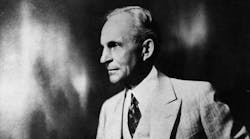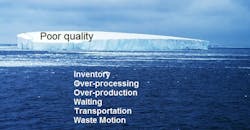Robert A. Heinlein's Stranger in a Strange Land defines "grok" as "to understand so thoroughly that the observer becomes a part of the observed." A real mechanic, for example, groks a machine while a parts changer can only follow directions to change a part. ISO 9001:2015's provision for "actions to address risks and opportunities" underscores the need to similarly grok the concept of waste or muda.
Taiichi Ohno (1988, 59), the father of the Toyota production system described this issue in detail.
"To implement the Toyota production system in your own business, there must be a total understanding of waste. Unless all sources of waste are detected and crushed, success will always be just a dream."
This article will convey the thought process, rather than a specific recipe, for identification and removal of waste.
Most Waste is Asymptomatic
ISO 9001:2008 focuses primarily on prevention (through an effective quality management system) and correction of poor quality. Poor quality in the form of defects is the only one of the Toyota production system's Seven Wastes that comes looking for us. Poor quality results in closed loop corrective action while the threat of poor quality results in preventive action. An employee might, for example, file what the Japanese call a hiyari (scare report) if he or she sees a situation that might result in the production of nonconforming items. The other six wastes do little or nothing to draw attention to themselves as shown by Figure 1 (Van Woert, TPS Seven Wastes added).
Shigeo Shingo elaborated explicitly (Robinson, 1990, 14), "Unfortunately, real waste lurks in forms that do not look like waste. Only through careful observation and goal orientation can waste be identified. We must always keep in mind that the greatest waste is the waste we don't see."
This hidden waste can easily be far more costly than the waste of poor quality that announces its presence or that we avoid proactively through the processes that ISO 9001:2008 and ISO/TS 16949 require.
Cost accounting systems recognize only the waste of poor quality in the form of unfavorable variances from the standard. The cost accounting system is no better equipped to detect the other wastes than a human is to see electromagnetic radiation outside the visible spectrum. Traditional cost accounting even defines inventory as an asset rather than a multiplier (per Little's Law) for cycle time as well as a hiding place for defects.
Frank Gilbreth's non-stooping scaffold, which enabled masons to lay 350 rather than 125 bricks per hour, is a perfect illustration of the need to grok, or understand completely, the concept of waste. Had ISO 9001 existed at the beginning of the 20th century, it would have focused on the quality of the bricks and mortar, the training and qualification of the brick layers, calibration of measuring equipment, and other factors to ensure the quality of the finished walls. It would have almost certainly overlooked the enormous waste motion that was built into the pre-Gilbreth job as described by Frederick Winslow Taylor (1911).
"Think of the waste of effort that has gone on through all these years, with each bricklayer lowering his body, weighing, say, 150 pounds, down two feet and raising it up again every time a brick (weighing about 5 pounds) is laid in the wall! And this each bricklayer did about one thousand times a day."
The 225 bricks per hour that were not laid because of the waste motion threw away 64% of the skilled workers' efforts, and sent them home with exhausted bodies and meager wages. The customers, meanwhile, paid far more than they should have paid, and the construction company's profits were much lower than they should have been.
When 64% or more of the job is waste effort, poor quality is probably the least of the organization's problems. Henry Ford (1922) said jobs could contain 95% waste effort, and fifty-fold productivity improvements at the Ford Motor Company proved this estimate realistic.
"The farmer makes too complex an affair out of his daily work. I believe that the average farmer puts to a really useful purpose only about 5 per cent of the energy that he spends. …A farmer doing his chores will walk up and down a rickety ladder a dozen times. He will carry water for years instead of putting in a few lengths of pipe. His whole idea, when there is extra work to do, is to hire extra men. He thinks of putting money into improvements as an expense. Farm products at their lowest prices are dearer than they ought to be. Farm profits at their highest are lower than they ought to be. It is waste motion --waste effort -- that makes farm prices high and profits low."
Grok the Value-Adding "Bang!"
A good way to grok wasted motion and wasted cycle time is to study musket loading drills from the 18th century. These drills were designed explicitly to eliminate any motion that did not contribute to the loading process. Baron von Steuben's (1779) "Regulations for the Order and Discipline of the Troops of the United States" looks a lot like a job breakdown sheet, which includes the number of motions that are necessary for each step of the loading drill. The musket volley was the literal value-adding "Bang!" as depicted later by Masaaki Imai (1997, 22-23) in the context of production. An infantry regiment produced value only when the muskets went "Bang!" and a stamping tool produces value only when it goes "Bang!"
Standard and Davis (1999, 61) convey the same principle through a golf game analogy. The club head is in contact with the ball for less than two seconds per 18-hole game, which may take four hours. The ratio of value-adding time to total cycle time can easily be the same in a traditional manufacturing shop. Workers who grok muda thoroughly, as Henry Ford's workers did, will recognize as waste any time in which the process does not actually transform the work.
The same concept carries over into the fast food industry, where $15 or even $20 an hour jobs are doubtlessly buried under the waste motion that is easily visible to anybody who groks waste thoroughly. Watch almost any fast food restaurant, and you will see that the workers spend most of their time walking, handling packaging, and indeed doing almost anything but value-adding work. The workers get little better than minimum wage, the food is overpriced and the owner's return on investment is far lower than what it should be. Order-taking kiosks, on the other hand, make higher wages and lower prices possible by eliminating the duplication of effort in which the customer places the order and the cashier forwards it to the food preparation area.
If You Can't Sell or Reuse It, It's Waste
Ford also defined as waste any purchased materials, including consumables, that do not become part of the finished product or cannot be re-sold for other purposes. Even metal chips from machining operations drew the immediate attention of production workers who understood fully the concept of waste. Distillation of waste wood into methyl alcohol, Kingsford charcoal, and other chemical products brought in $12,000 a day, or enough to pay 2000 workers $6 a day. (The dollars were made of silver back then, and a dime could buy a loaf of bread.) Slag from Ford's blast furnaces was re-sold as cement and paving material, and solvent fumes were adsorbed and reused to the extent that a single gallon did the work of 10.
Shigeo Shingo (Robinson, 1990, 101-103) meanwhile asked a plant manager whether the purpose of a spray booth was to paint parts or paint air, for the paint that missed the parts was not only waste but also an environmental problem. We can add to this, "Ship parts and not air (or water)" because it costs money to transport air in packaging or, even worse, water. The latter is why many garden chemicals come in highly concentrated forms, and why a cup of tea from a tea bag or loose tea is far less expensive than bottled tea. Henry Ford would not even transport the water in green wood; he dried the wood before he sent it anywhere.
Ford also showed that even the TPS's Seven Wastes do not encompass the waste of omission. This is where the "opportunities" part of ISO 9001:2015's provision for "actions to address risks and opportunities" becomes very important.
The Waste of Omission
Ford (1922) described the waste of omission in a single sentence. "If a device would save in time just 10 per cent. or increase results 10 per cent., then its absence is always a 10 per cent. tax."
Consider, for example, the centuries-old factory operation of machining. Several articles (Society of Manufacturing Engineers) and advertisements (5ME) show how cryogenic machining, which uses liquid nitrogen or carbon dioxide instead of a traditional cutting fluid, (1) increases cutting speeds, (2) increases the life of the cutting tool, and (3) discharges nitrogen or carbon dioxide gas rather than an environmental problem. This is but one example of how failure to implement new technology where appropriate concedes an enormous advantage to competitors who do.
In summary, ISO 9001:2008 focuses primarily on avoidance of poor quality. The ability to grok, or understand thoroughly, all other forms of waste is a prerequisite for the kind of phenomenal growth that the Ford Motor Co. proved possible during the first part of the 20th century.
William A. Levinson, P.E., is the principal of Levinson Productivity Systems, P.C. He is the author of The Expanded and Annotated My Life and Work: Henry Ford's Universal Code for World-Class Success, and numerous other books on quality, management, and productivity.
References:
Ford, Henry, and Crowther, Samuel. 1922. My Life and Work. New York: Doubleday, Page & Company
Heinlein, Robert A. 1961. Stranger in a Strange Land. New York: Putnam Publishing Group
Imai, Masaaki. 1997. Gemba Kaizen. New York: McGraw-Hill
Ohno, Taiichi. 1988. Toyota Production System: Beyond Large-Scale Production. Portland OR: Productivity Press
Robinson, Alan (editor), 1990. Modern Approaches to Manufacturing Improvement: The Shingo System. Portland: Productivity Press
Standard, Charles, and Davis, Dale. 1999. Running Today's Factory: A Proven Strategy for Lean Manufacturing. Cincinnati: Hanser Gardner Publications
Taylor, Frederick Winslow. 1911. The Principles of Scientific Management. New York: Harper Brothers.
Van Woert, Michael. National Oceanic and Atmospheric Administration. Iceberg in the Ross Sea, Antarctica




